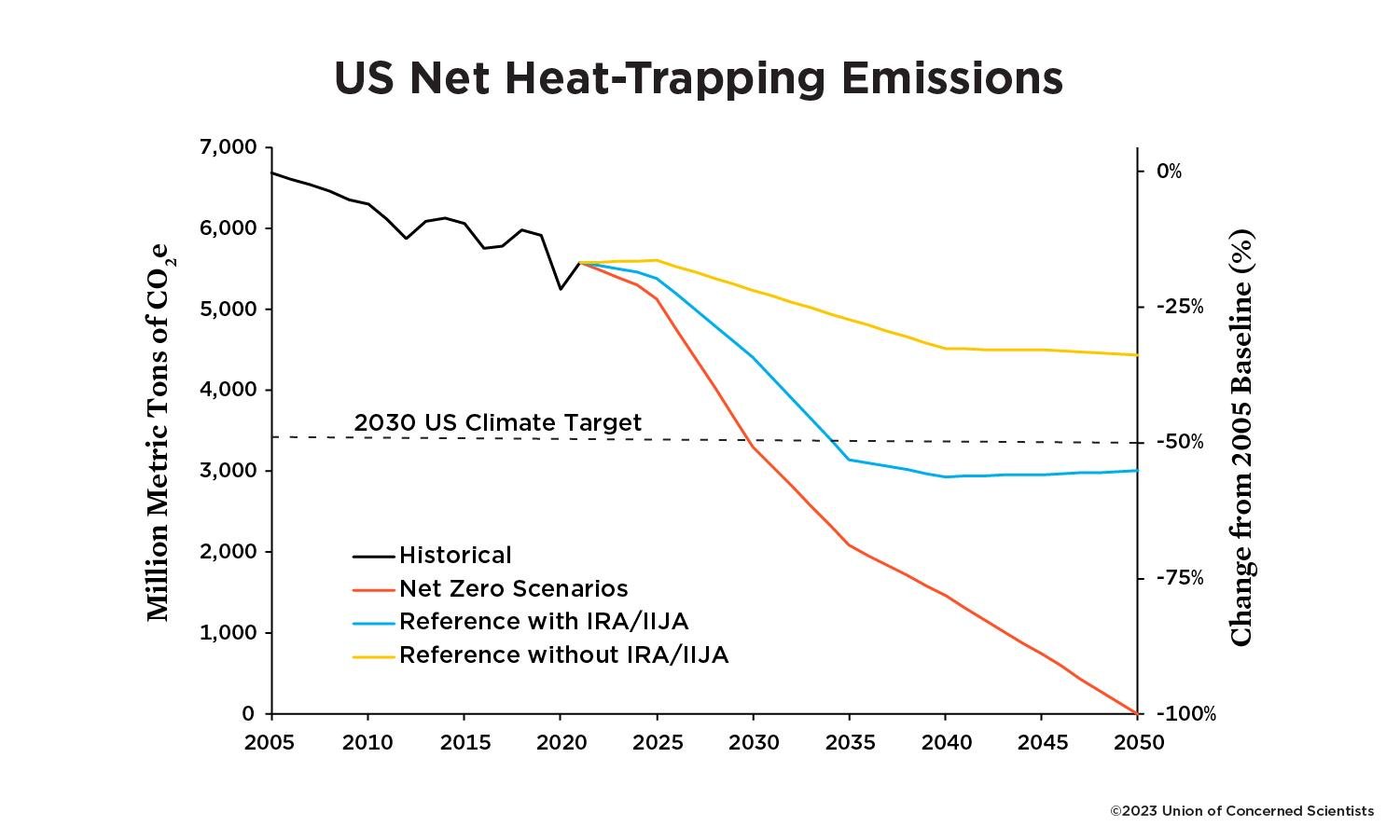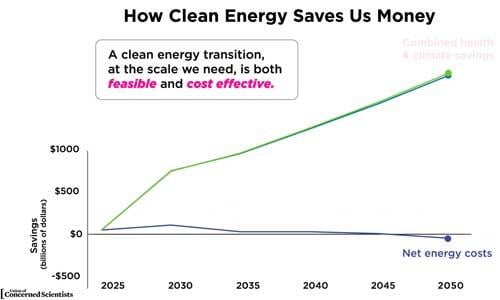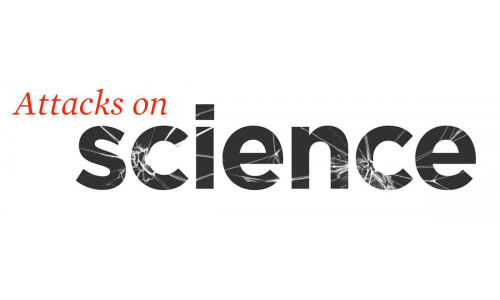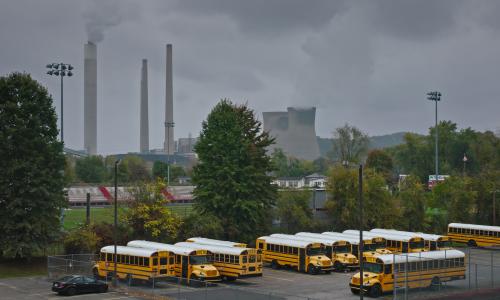A transformative clean energy transition is both feasible and hugely beneficial to the economy, climate, and public health—but will require concerted action.
We examined the tremendous opportunities—and challenges—for the United States as it seeks to reduce its heat-trapping emissions in line with science-informed goals.
Specifically, we analyzed four scenarios for changing the US energy system, including two “Net Zero” scenarios for decarbonizing the US economy by 2050, as well as two reference cases with and without the Inflation Reduction Act and Infrastructure Investment and Jobs Act.
By rapidly phasing out fossil fuels and transitioning to clean energy, the United States can meet its climate targets with lower near-term energy costs and only modest long-term costs. We also found enormous economic, health, and climate benefits to transforming the energy system—including more than $800 billion in annual public health savings, and nearly $1.3 trillion in avoided climate damages by 2050.
Accelerating Clean Energy Ambition
This is an online version of the Executive Summary. For the full text, please download the white paper and supporting documents.
Rapidly worsening impacts from human-caused climate change raise the urgency of deep, swift cuts in global heat-trapping emissions. A Union of Concerned Scientists (UCS) analysis examines the tremendous opportunities—and challenges—for the United States as it seeks to reduce its heat-trapping emissions in line with science-informed goals, meet its international commitments, and, at the same time, realize significant economic and public health benefits. Achieving these ambitious and necessary goals requires bold, transformative change across every sector of the economy and across institutions and society. Clean energy policies beyond the Inflation Reduction Act and other existing federal and state measures are necessary, as are new policies driving a fast, fair phaseout of fossil fuels. We recommend that policymakers act boldly, moving the nation toward equitable, just solutions that center the well-being of people and communities.
Meeting US Climate Goals
UCS analyzed changes in the US energy system aligned with cutting heat-trapping emissions at least 50 percent below 2005 levels by 2030 and reaching net-zero emissions no later than 2050. Using models developed by Evolved Energy Research, we looked at four scenarios. Two “Net Zero” scenarios meet the targets: one scenario represents a least-cost mix of technologies and resources to meet the projected demand for energy services based on recent trends; the second, a Net Zero/Low Demand scenario, adds in feasible reductions in energy demand beyond what energy efficiency measures and technological changes alone could achieve. We compared those results to two reference scenarios, one considering and one without considering the Inflation Reduction Act (IRA) and Infrastructure Investment and Jobs Act (IIJA). The United States would not meet its climate targets in either reference case.
By rapidly phasing out fossil fuels and transitioning to clean energy, the United States can meet its climate targets with near-term savings and only a modest long-term cost. Simultaneously, our analysis shows, the nation can gain significant economic, public health, and climate benefits:
-
The window for the United States to meet its climate targets is closing fast. Pathways exist to meet US climate targets, but they all require us to immediately and significantly ramp up the deployment of clean energy technologies and related infrastructure. While the IRA and IIJA deliver significant progress—more than doubling today’s pace of emissions reductions to about 3 percent per year through 2030—we need additional policies and investments across all sectors to increase reductions to more than 5 percent per year and achieve US climate targets (Figure 1).
-
Rapidly phasing out fossil fuels is key to meeting US climate targets. In the two Net Zero scenarios, fossil fuel use falls at least 50 percent between 2021 and 2040; by 2050, it falls 82 percent in the Net Zero case and 85 percent in the Net Zero/Low Demand case.
-
Transitioning to clean energy drives significant investment. Between 2023 and 2035, the IRA and IIJA help decarbonize the economy, driving nearly $1.6 trillion in capital investments in clean energy and related infrastructure. More than 80 percent is for wind, solar, energy storage, and transmission investments. Under the Net Zero case, these investments are slightly higher over the near-term and much higher over the longer term, reaching nearly $3.7 trillion through 2050.

-
Fossil fuel savings and IRA incentives offset higher energy-system costs. Effective implementation of the IRA and IIJA lowers annual energy expenditures by nearly 3 percent, saving households, businesses, and industry $89 billion in 2030, with lasting annual savings through 2050. Achieving US climate goals under the Net Zero case results in more than $101 billion in net savings in 2030, and savings continue through 2040. Under this scenario, health and climate benefits more than offset modest net energy system costs of $46 billion in 2050.
-
The health and climate benefits of phasing out fossil fuels exceed the costs. Clean energy investments due to the IRA and IIJA reduce key air pollutants, such as nitrogen oxides and sulfur dioxide, by more than 50 percent between 2021 and 2035. Reductions in fine particulate matter alone could avoid thousands of premature deaths, saving hundreds of billions of dollars in 2035 from avoided mortalities. By 2050, the Net Zero cases more than double the monetized benefits, saving $370 billion to $860 billion in health care costs and avoiding nearly $1.3 trillion in climate-caused damage.
-
Three key solutions account for most of the emissions reductions needed to meet US climate targets. All three are proven, commercially available, and can lower energy bills, increase public health benefits, and readily be ramped up to much higher levels.
-
Decarbonizing electricity generation: Wind, solar, and other renewables nearly triple to account for 60 percent of US electricity generation in 2030 and 92 percent in 2050 under the Net Zero case, while coal is phased out by 2030 and gas falls to 25 percent in 2030 and 2 percent in 2050. The IRA drives most of the near-term deployment of wind and solar. To help integrate high levels of wind and solar and deliver power where it is needed, energy storage capacity increases nearly six-fold between 2021 and 2030 and 20-fold by 2050; US transmission capacity more than doubles by 2040, and quadruples by 2050 under the Net Zero case.
-
Electrification: Electricity use as a share of US energy demand increases from 21 percent in 2021 to 53 percent in 2050 under the Net Zero and Net Zero/Low Demand cases. Rapid growth in electric vehicles and highly efficient electric heat pumps in buildings drives most of this increase.
-
Energy efficiency: Improving the efficiency of buildings, industry, and transportation reduces per-capita energy use 20 percent between 2021 and 2050 in the IRA/IIJA case, 35 percent in the Net Zero case, and 45 percent in the Net Zero/Low Demand case.
-
-
Deep, rapid reductions involve technologies with significant tradeoffs. The three core clean energy strategies cannot completely eliminate the need for some polluting processes and technologies. For example, it is challenging or infeasible for direct electrification to replace fully the fuels for long-distance air travel, fertilizer production, steelmaking, or cement manufacturing. All four scenarios would require a limited deployment of technologies—biofuels/bioenergy, hydrogen, carbon capture and utilization or storage—involving significant environmental and societal risks and tradeoffs.
Policy Recommendations
Achieving deep, economy-wide reductions in heat-trapping emissions, alongside equally ambitious cuts in other pollutants that harm public health and drive environmental injustices, will require transformative policies, investments, and institutions within this decade and beyond. We recommend commitments from policymakers to:
-
Set science-based reduction goals covering all heat-trapping emissions, informed by global equity considerations, and meeting the US commitment to a 50 to 52 percent reduction below 2005 levels by 2030 and net-zero emissions no later than 2050;
-
Enact ambitious, robust policies and investments across every sector, building on the IRA, IIJA, and other existing policies, to achieve a massive shift to clean energy, energy efficiency, and electrification, along with the infrastructure to enable those gains;
-
Phase out fossil fuels by adopting near- and long-term plans to cut fossil fuel production and use, reject the expansion of large, long-lived, fossil fuel infrastructure, and set a high bar for integrity for the limited role for carbon-management strategies;
-
Make broader societal shifts that lower energy demand, thus reducing the overall rate and scale of the buildout of wind, solar, transmission, storage, and other zero-carbon technologies and simultaneously reducing the need for minerals used in renewable energy, land, new infrastructure, and challenges related to siting, permitting, supply chains, and public acceptance;
-
Align climate, public health, environmental justice, and worker justice goals to ensure that climate policies yield robust reductions of harmful co-pollutants in overburdened communities and prioritize both clean energy investments within those communities and investments in just transitions for workers and communities now dependent on fossil fuels;
-
Incorporate climate projections and resilience measures in planning, building, upgrading, and expanding clean energy infrastructure to ensure it is fit for a warming world;
-
Inclusive and fair governance and decisionmaking to ensure that a clean energy transition produces equitable benefits for all, especially those most marginalized and disadvantaged; and
-
Hold fossil fuel companies accountable for deception and damages, for instead developing and implementing robust plans for phasing out fossil fuels, and for complying with newly adopted regulations and policies that mandate climate-aligned purchasing and investment decisions.
Policymakers have the responsibility to put the nation firmly on the path to a better future, running on clean energy and free of the fossil fuel pollution driving the twin crises of climate change and environmental injustice. With the well-being of people, ecosystems, and the planet at stake, our choice is clear.
This is an online version of the Executive Summary. For the full text, please download the white paper and supporting documents.
Citation
Clemmer, Steve, Rachel Cleetus, Jeremy Martin, Maria Cecilia Pinto de Moura, Paul Arbaje, Maria Chavez, and Sandra Settler. 2023. Accelerating Clean Energy Ambition: How the United States Can Meet Its Climate Goals While Delivering Public Health and Economic Benefits. Cambridge, MA: Union of Concerned Scientists. https://doi.org/10.47923/2023.15253






